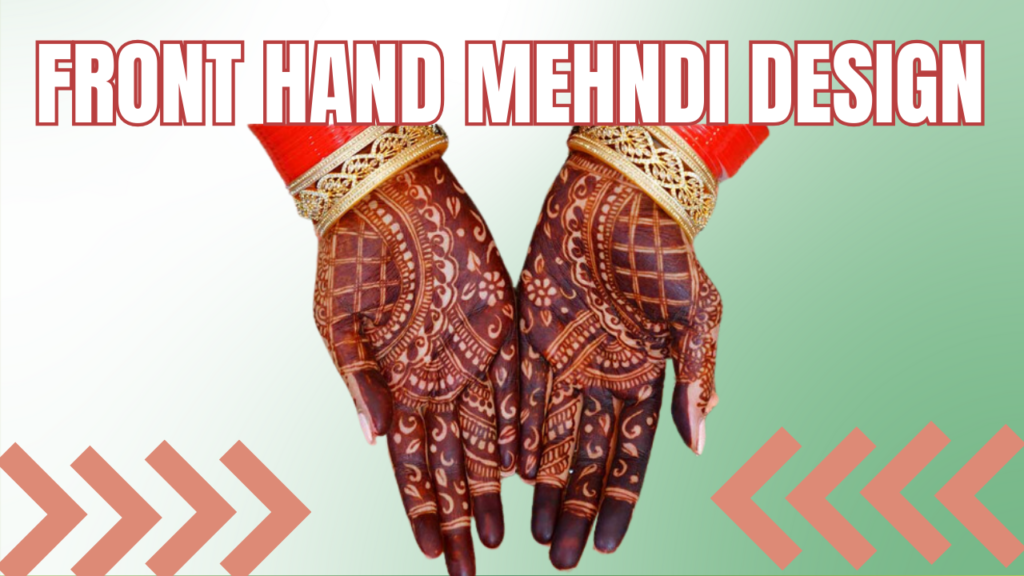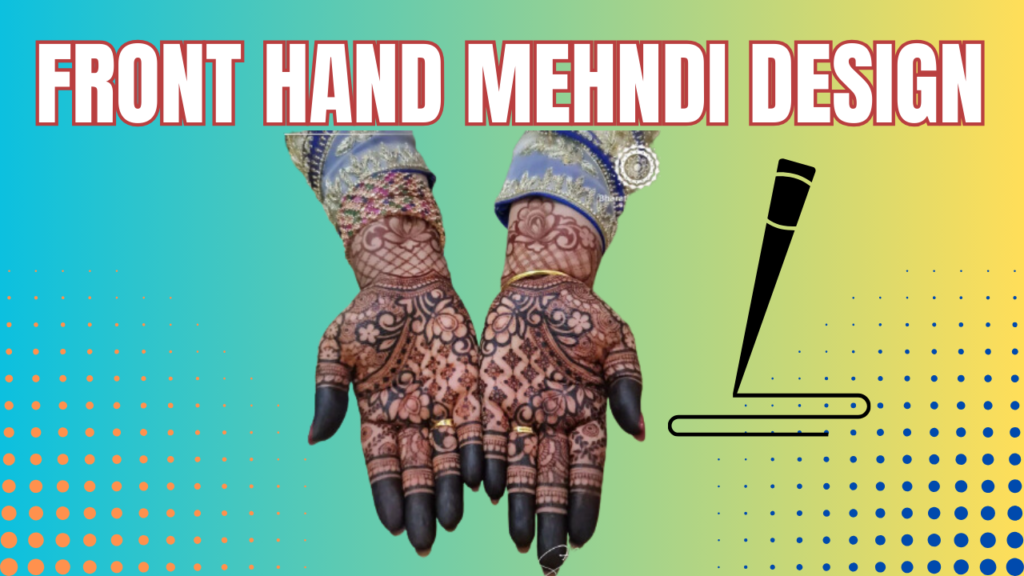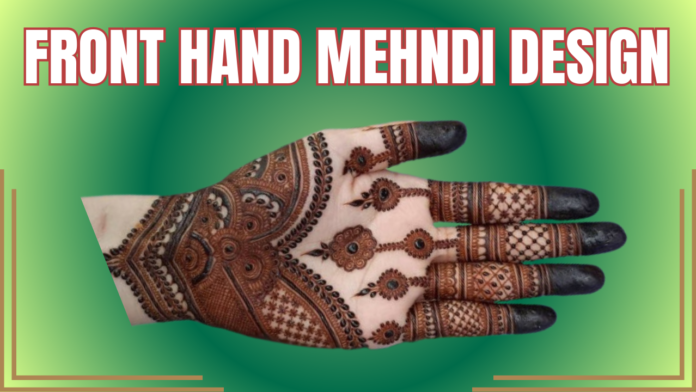Front hand mehndi designs
1. Introduction
Brief History of Mehndi: Front hand mehndi designs Trace the origin of mehndi, tracing its roots back to ancient times in India, the Middle East and North Africa.
Significance in Culture and Traditions: Discuss how mehndi is more than just body art, highlighting its role in weddings, festivals and religious ceremonies.
Introduction to Front Hand Mehndi: Explain why front hand mehndi designs are popular and how they can range from simple to elaborate depending on the occasion.
2. Basics of Applying Mehndi
Materials and Tools Required: Front hand mehndi designs Explain the tools needed, such as cones, stencils and natural henna powder, and how to prepare the henna paste.
Skin Preparation: Discuss the steps to prepare the skin for better adhesion of the mehndi, including exfoliation and cleansing.
Application Technique: Cover the basic techniques of holding the cone, applying pressure and creating basic shapes such as dots, lines and curves.
3. Step-by-Step Front Hand Mehndi Designs for Beginners
Starting with simple patterns: Front hand mehndi designs Provide detailed instructions for creating basic patterns such as flowers, vines, and paisley. Include visual details and references to aid beginners.
Gradually building complexity: Explain how to gradually add more elements to the design without overwhelming beginners. Start from the center of the palm and work outward toward the fingers.
Symmetry and balance in designs: Teach beginners how to maintain symmetry in their patterns, preferably on both hands. Provide tips on how to keep the design consistent and creative.
4. Popular patterns for front hand mehndi
Flower and leaf patterns: Provide examples of simple flower and leaf designs that can be extended. Break down the steps to create these patterns effectively.
Geometric and abstract patterns: Discuss the popularity of geometric shapes and explain how they can be used to create modern but simple front hand mehndi designs.
Traditional patterns with a twist: Provide tutorials on how to incorporate traditional patterns like mandala or paisley while keeping the design simple for beginners.
5. Mehndi design ideas for different occasions
For everyday wear: Find minimalist designs that are suitable for everyday use. Focus on subtle but elegant patterns.
Festivals and celebrations: Provide ideas for slightly more complex patterns that are simple enough for beginners but elegant enough for festivals like Eid, Diwali or Karva Chauth. Front hand mehndi designs

Wedding ceremonies: Teach beginners how to create slightly more elaborate designs for weddings and pre-wedding ceremonies while keeping it manageable for their skill level.
6. Care Tips for Long-Lasting Mehendi
What to do immediately after application: Explain the best ways to care for mehendi after applying it, such as letting it dry properly and avoiding water.
Ways to darken the stain: Front hand mehndi designs Discuss traditional methods such as applying a mixture of lemon and sugar, keeping the mehendi warm, and letting the paste sit for a long time.
Maintaining the design: Explain ways to keep the design intact for as long as possible, including avoiding rubbing hands and moisturizing the skin.
7. Common mistakes to avoid for beginners
Inconsistent pressure: Front hand mehndi designs Explain the problems that arise from uneven pressure when applying mehendi and how to practice controlling the cone.
Messy designs: Discuss how to keep the design clean and avoid smudging during and after application.
Not letting the mehendi dry properly: Emphasize the importance of patience in allowing the mehendi to dry completely before removing it.
8. Troubleshooting in applying mehendi
Correcting mistakes during application: Provide tips on how to correct mistakes without ruining the entire design.
Dealing with uneven stains: Front hand mehndi designs Explain why stains can be uneven and how this can be prevented in the future.
Managing allergies or skin reactions: Provide advice on how to test for skin reactions before full application and what to do if an allergic reaction occurs.
9. Advanced tips to improve your skills
Practice makes perfect: Encourage beginners to practice regularly on paper or plastic sheets to hone their skills before applying it on the skin.
Discovering online tutorials and workshops: Highlight the importance of learning from video tutorials, attending workshops and following mehendi artists on social media for inspiration.
Experimenting with different styles: Encourage beginners to experiment with different mehndi styles, such as Arabic, Indian or Moroccan, as they build confidence.
10. Conclusion
Summary of the learning journey: Front hand mehndi designs Summarize the importance of patience and practice when learning mehndi designs.
Encouragement for continued practice: Encourage readers to continue exploring new patterns and hone their craft.
Final thoughts on the beauty of simple and elegant mehndi designs: Conclude with a reflection on the timeless beauty of mehndi and its significance in various cultures around the world.
Simple and Elegant Front Hand Mehndi Designs for Beginners Step by Step Type
Here is a simple and step-by-step guide to creating elegant front hand mehndi designs for beginners:
Step 1: Gather your materials
Before you begin, make sure you have the following materials ready:
Henna cone: A prepared henna cone or freshly prepared paste in a cone.
Lemon-sugar mixture: To help deepen the color of the henna.
Cotton balls: To apply the lemon-sugar mixture.
A small towel or tissue: To wipe off excess henna or correct mistakes. Front hand mehndi designs

Step 2: Prepare your hands
Clean your skin: Wash your hands with soap and water to remove any oils or lotions that may prevent the henna from sticking properly.
Dry completely: Make sure your hands are completely dry before you start applying the henna.
Step 3: Start with basic shapes
Practice dots and lines: Start by practicing small dots and lines on paper to get comfortable with the flow of the cone. Make sure you apply gentle, even pressure.
Draw a flower in the center of the palm: Start by drawing a simple flower with five to six petals in the center of your palm. Use short, even strokes for the petals and make the center of the flower a small dot.
Step 4: Create borders
Draw outlines with simple vines: From the flower, draw smaller vines curving outward. These vines can have small leaves, curved lines, or dots. These borders will help define the overall design and make it look more beautiful.
Step 5: Add details on the fingers
Start with simple finger patterns: Start at the base of each finger and work your way up, creating small, repeated patterns like dots, circles, and curved lines. For simplicity, you can also choose a series of small flowers or leaves along the length of the fingers.
Step 6: Incorporate smaller motifs
Fill in the spaces: Use smaller motifs like teardrops, paisleys, or hearts to fill in the spaces around the center design and on the sides of your palm. The goal is to keep the design simple but elegant without being overcrowded.
Step 7: Focus on symmetry
Patterns the design: If you are designing both hands, try patterning the design on the opposite hand. Start with the same basic shapes and work on achieving symmetry in the design layout.
Step 8: Dry the henna
Let the henna dry completely: Allow the henna paste to dry for at least 2-4 hours. The longer you leave it on, the darker the stain will be.
Apply the lemon-sugar mixture: When the henna begins to dry and crack, gently apply the lemon-sugar mixture over the design using a cotton ball to darken the stain.
Step 9: Remove the Henna Paste
Scrape off gently: After the paste has dried completely, gently scrape off the henna. Do not wash your hands with water immediately after removal. Instead, use a dry towel or tissue.
Step 10: Care for the Mehendi Design
Avoid water for 24 hours: Try to avoid getting the design wet for at least 24 hours. Water can cause the design to fade faster.
Apply oil: Apply natural oil (coconut or olive oil) on the design to protect the stain and make it last longer.
By following these steps, you will be able to create a beautiful and simple front hand mehndi design that is perfect for any occasion.
FAQs
Here are some Frequently Asked Questions (FAQs) related to “Simple and Elegant Front Hand Mehndi Designs for Beginners”:
FAQs about Front Hand Mehndi Designs
1. What is a front hand Mehndi design?
Front hand Mehndi designs focus on decorating the palm, fingers, and the front part of the hand. These designs are often simpler and more elegant compared to backhand designs, making them ideal for beginners.
2. How long does it take to apply a simple front hand Mehndi design?
For beginners, a simple front hand Mehndi design typically takes about 30 to 60 minutes to apply, depending on the complexity of the design.
3. How long does a Mehndi design last on the hand?
A Mehndi design usually lasts between 1 to 3 weeks. The longevity depends on factors such as skin type, aftercare, and exposure to water.
4. How can I ensure my front hand Mehndi design lasts longer?
To ensure your Mehndi design lasts longer:Front hand mehndi designs
- Keep the Mehndi paste on for at least 4-6 hours before removing it.
- Avoid washing your hands immediately after removing the dried paste.
- Apply lemon-sugar mixture during the drying process.
- Protect the design by moisturizing it with natural oils.
5. What are the best Mehndi patterns for beginners?
The best patterns for beginners include simple floral motifs, leaves, vines, dots, and geometric shapes. These patterns are easy to execute and help build confidence before moving on to more complex designs.
6. Can I practice Mehndi on surfaces other than the skin?
Yes, you can practice Mehndi designs on paper, plastic sheets, or even a practice hand model. This helps improve your precision and control before applying Mehndi to the skin.
7. Is there a way to fix mistakes while applying Mehndi?
Mistakes can be fixed by gently wiping off the incorrect section with a tissue or cotton ball before it dries. If the henna has dried, use a small, sharp object to scrape off the mistake carefully.
8. Are there specific front hand designs for different occasions?
Yes, you can customize front hand Mehndi designs for various occasions. For everyday or casual looks, simple and minimalist designs work well, while more intricate patterns are suitable for weddings and festivals.
9. Can I create my own Mehndi paste at home?
Yes, you can make your own Mehndi paste by mixing henna powder with water, lemon juice, and essential oils like eucalyptus or tea tree oil. Let the paste sit for a few hours before using it for application.
10. How do I avoid staining clothes or surroundings while applying Mehndi?
To avoid staining, wear old clothes while applying Mehndi and place a towel or sheet under your hands. Be cautious with the paste, and keep the cone tip away from unwanted surfaces.
These FAQs should help address common concerns and questions for beginners exploring front hand Mehndi designs. Let me know if you need more information!


